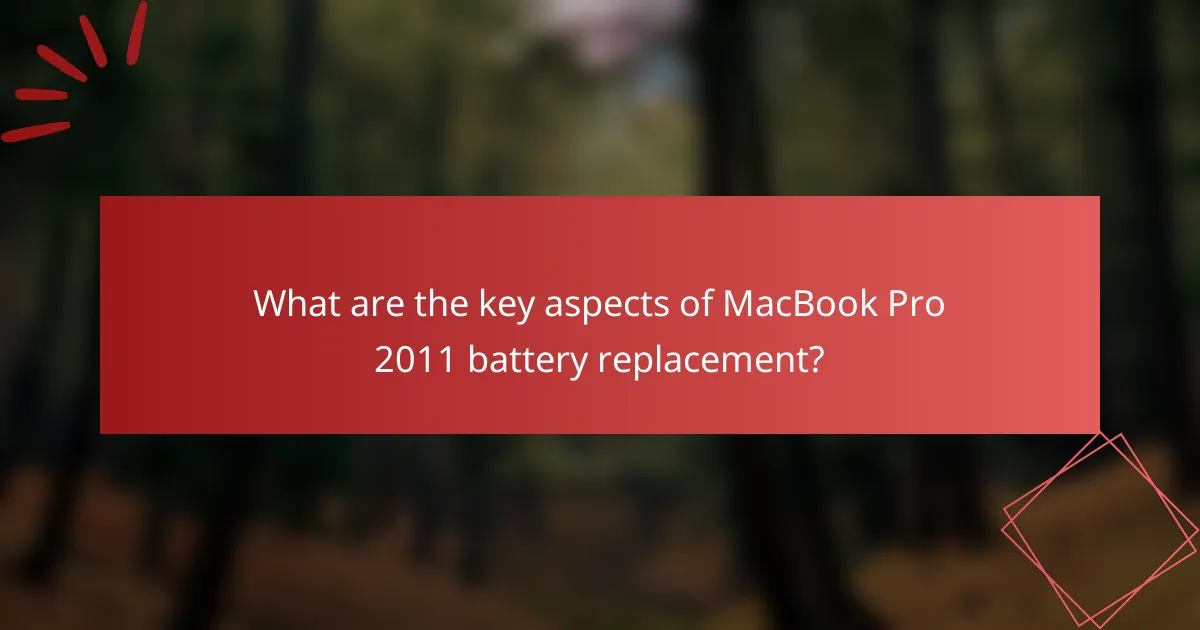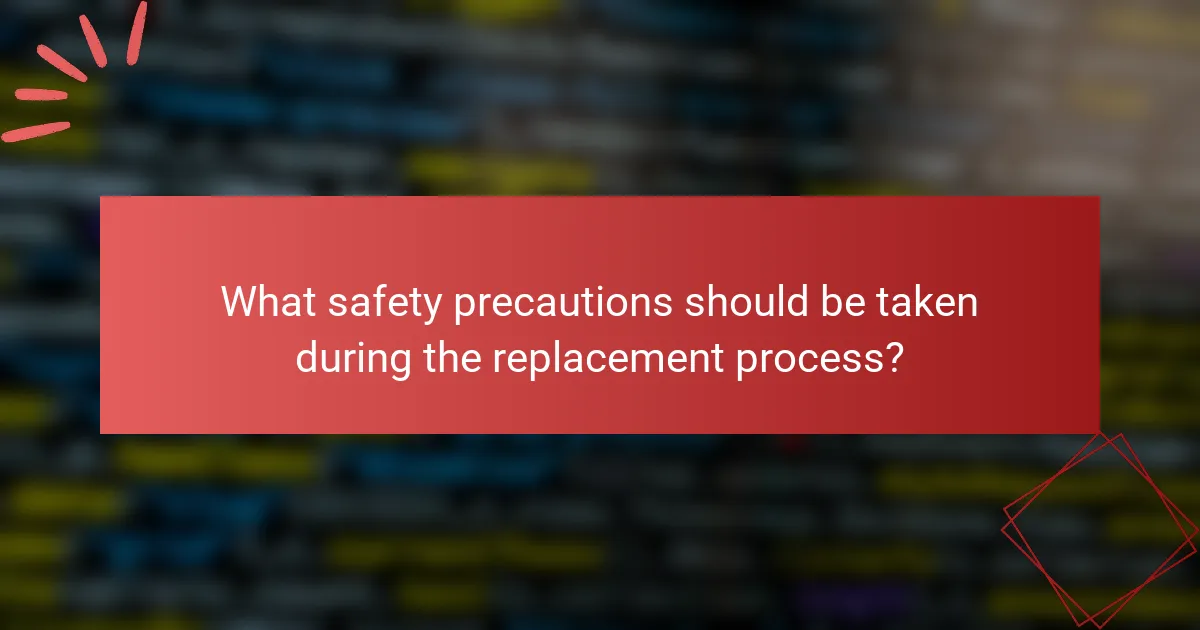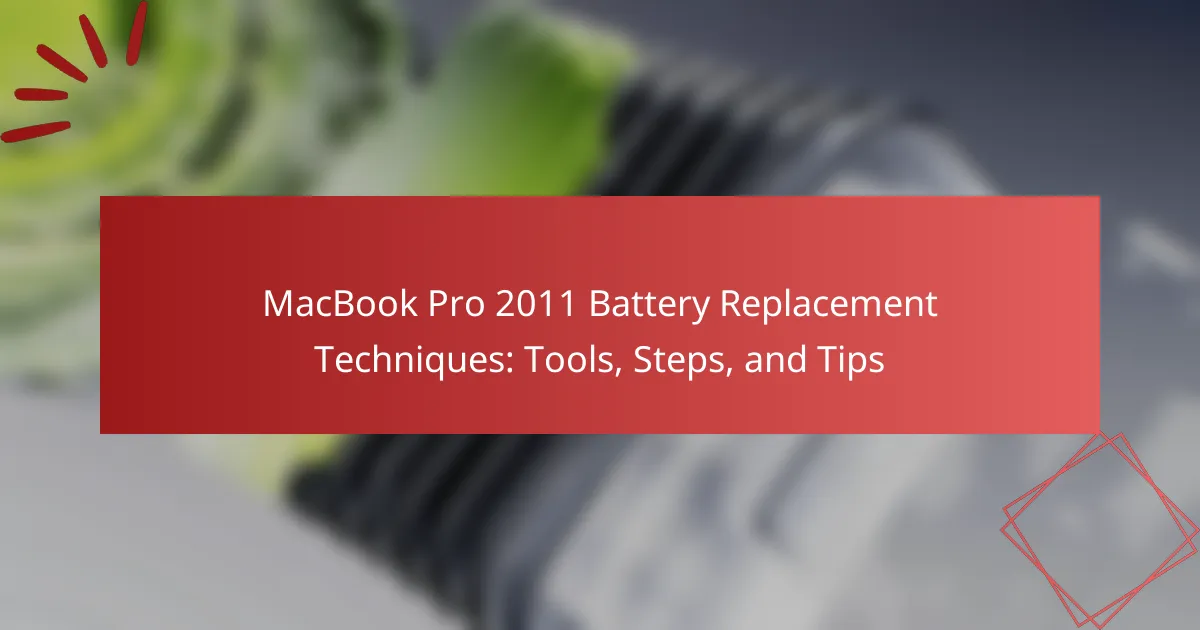The MacBook Pro 2011 battery replacement process involves identifying the correct 10.95V lithium-polymer battery type and utilizing essential tools such as a Phillips screwdriver, spudger, and tweezers. Key steps include powering down the device, removing the back cover, disconnecting the battery, and installing the new battery while taking safety precautions to prevent injury and damage. Best practices for maintaining optimal battery performance post-replacement include calibrating the battery, avoiding extreme temperatures, and regularly checking battery health. Following these guidelines ensures a successful battery replacement and extends the lifespan of the new battery.

What are the key aspects of MacBook Pro 2011 battery replacement?
The key aspects of MacBook Pro 2011 battery replacement include identifying the correct battery type, using appropriate tools, and following specific steps for safe removal and installation. The battery type for the MacBook Pro 2011 is typically a 10.95V lithium-polymer battery. Tools required include a Phillips screwdriver, a spudger, and tweezers.
To replace the battery, first, power down the device and disconnect it from any power source. Next, remove the back cover using the Phillips screwdriver. Carefully disconnect the battery connector from the logic board using the spudger. Remove the battery by unscrewing it from its enclosure.
After that, place the new battery in the same position and reconnect it to the logic board. Finally, reattach the back cover and power on the MacBook Pro. Following these steps ensures a successful battery replacement while minimizing the risk of damage.
How does the battery replacement process impact MacBook Pro performance?
Battery replacement can significantly enhance MacBook Pro performance. A new battery restores optimal power delivery. This ensures the device runs efficiently without sudden shutdowns. Old batteries often cause throttling due to insufficient power. A fresh battery also improves overall battery life. Users can expect longer usage times between charges. Additionally, it reduces heat generation, which can affect performance. Studies indicate that degraded batteries impact processing speeds negatively. Therefore, replacing the battery is crucial for maintaining performance standards.
What symptoms indicate that the battery needs replacement?
A MacBook Pro 2011 battery needs replacement when it shows specific symptoms. Common indicators include rapid battery drain, where the battery discharges quickly despite being fully charged. Additionally, the battery may swell, causing physical deformation of the laptop casing. Another sign is the inability to hold a charge, leading to unexpected shutdowns even with remaining battery percentage. Frequent overheating during use also suggests battery issues. Lastly, the battery health status may show a significant drop in capacity, often below 80%. These symptoms collectively indicate that the battery is failing and requires replacement.
How does a new battery affect overall device functionality?
A new battery significantly enhances overall device functionality. It provides reliable power supply, ensuring the device operates efficiently. A fresh battery improves performance by maintaining optimal voltage levels. This leads to longer usage times without interruptions. Additionally, a new battery can prevent unexpected shutdowns and data loss. It also supports faster charging cycles, improving user experience. Overall, the device’s responsiveness and speed increase with a new battery. This is especially important for intensive tasks that require consistent power.
What tools are necessary for replacing the MacBook Pro 2011 battery?
The tools necessary for replacing the MacBook Pro 2011 battery include a Phillips #00 screwdriver, a plastic spudger, and a suction cup. The Phillips #00 screwdriver is essential for removing the screws securing the back cover. The plastic spudger helps to safely detach the battery from the adhesive. A suction cup is useful for lifting the back cover without damaging the device. These tools are standard for battery replacement in this model.
Which specific tools are recommended for this replacement?
For replacing the MacBook Pro 2011 battery, specific tools are recommended. A P5 Pentalobe screwdriver is needed to remove the screws securing the bottom case. A T6 Torx screwdriver is essential for detaching the battery connector. A spudger helps safely pry the battery away from the adhesive. Tweezers are useful for handling small components during the process. Additionally, a suction cup can assist in lifting the bottom case without damage. These tools ensure a smooth and effective battery replacement.
How do these tools facilitate the battery replacement process?
Tools such as screwdrivers, spudgers, and suction cups facilitate the battery replacement process in MacBook Pro 2011 models. Screwdrivers allow for the removal of screws securing the battery. Spudgers help in safely prying open the device without damaging components. Suction cups assist in lifting the battery out of the casing without applying excessive force. Each tool is specifically designed for precision and ease of use. This ensures that users can replace the battery with minimal risk of damaging the laptop. Using the correct tools streamlines the process and enhances safety during replacement.
What steps should be followed for a successful battery replacement?
Turn off the MacBook Pro 2011 and disconnect it from power. Use a P5 Pentalobe screwdriver to remove the screws from the bottom case. Carefully lift the bottom case off to expose the battery. Disconnect the battery connector from the logic board using a plastic spudger. Remove the battery by unscrewing it from the chassis. Place the new battery in the same position as the old one. Reconnect the battery connector to the logic board securely. Replace the bottom case and reinsert the screws to secure it. Finally, power on the MacBook Pro to ensure the new battery is functioning correctly.
How do you safely disassemble the MacBook Pro 2011?
To safely disassemble the MacBook Pro 2011, follow these steps. First, ensure the device is powered off and unplugged. Next, remove the ten screws from the bottom case using a P5 Pentalobe screwdriver. Carefully lift the bottom case off to expose the internal components. Disconnect the battery connector from the logic board to prevent electrical damage. Use a spudger to gently pry up the battery from its adhesive. Remove the battery by lifting it out of the case. Follow these instructions to prevent damage to the components and ensure safety during disassembly.
What are the essential steps to remove the old battery?
1. Power off the MacBook Pro 2011. This prevents electrical damage during the process.
2. Unplug the power adapter from the device. This ensures safety while working on the laptop.
3. Remove the bottom case screws using a P5 Pentalobe screwdriver. There are ten screws to take out.
4. Carefully lift the bottom case off to expose internal components. This reveals the battery connection.
5. Disconnect the battery connector from the logic board. This step is crucial to ensure no power flows to the battery.
6. Remove the screws securing the battery to the chassis. There are three screws that need to be taken out.
7. Gently lift the battery out of the MacBook Pro. Ensure no wires are caught during removal.
8. Dispose of the old battery according to local regulations. Proper disposal is important for environmental safety.
How do you install the new battery correctly?
To install the new battery correctly in a MacBook Pro 2011, first, power off the device and unplug it. Next, remove the back cover using a P5 Pentalobe screwdriver. Disconnect the old battery by carefully lifting the connector from the logic board. Place the new battery in the designated slot, ensuring it aligns with the connectors. Connect the new battery to the logic board securely. Replace the back cover and tighten the screws. Finally, power on the MacBook to verify the installation was successful. Following these steps ensures proper installation and functionality of the new battery.

What safety precautions should be taken during the replacement process?
Wear protective eyewear to shield your eyes from potential debris. Use anti-static wrist straps to prevent electrostatic discharge. Disconnect the MacBook Pro from any power source before starting the replacement. Remove the battery carefully to avoid puncturing it, which can cause fire or chemical leaks. Work in a well-ventilated area to minimize inhalation of fumes from any damaged components. Keep tools organized to prevent losing small parts and avoid injury. Follow manufacturer guidelines for safe handling and disposal of the old battery. These precautions are essential to ensure personal safety and prevent damage to the device.
Why is it important to follow safety guidelines when replacing the battery?
Following safety guidelines when replacing the battery is crucial to prevent accidents and damage. Batteries can contain hazardous materials that may leak or cause fires if mishandled. Proper guidelines ensure safe disposal of old batteries, preventing environmental harm. They also protect users from electric shock during the replacement process. Additionally, adhering to safety protocols helps maintain the integrity of the device, avoiding potential damage to internal components. Statistics show that improper battery handling leads to a significant number of injuries each year. Thus, following safety guidelines is essential for user safety and device longevity.
What personal protective equipment should be used?
Safety goggles should be used to protect the eyes during battery replacement. Gloves are essential to prevent skin contact with harmful substances. A dust mask can help avoid inhaling any particles or fumes. An anti-static wrist strap is important to prevent damage to electronic components. These protective equipment items minimize the risk of injury and ensure a safer working environment. Using safety goggles prevents eye injuries from debris. Gloves protect against chemical exposure from the battery. A dust mask reduces the risk of respiratory issues. An anti-static wrist strap protects sensitive electronic parts from static electricity.
How can you avoid damaging other components during replacement?
To avoid damaging other components during a MacBook Pro 2011 battery replacement, use appropriate tools. Employ a plastic spudger to gently pry open the device. Avoid metal tools, as they can cause short circuits. Disconnect the battery before removing other components. This prevents accidental power surges. Work in a static-free environment to protect sensitive parts. Ground yourself to avoid electrostatic discharge. Follow a step-by-step guide to ensure proper disassembly. This minimizes the risk of damaging connectors and cables.
What troubleshooting tips can help during the battery replacement?
Ensure you have the correct replacement battery model for your MacBook Pro 2011. Using an incompatible battery can lead to performance issues. Carefully follow the manufacturer’s instructions during the replacement process. This minimizes the risk of damaging internal components. Use appropriate tools, such as a pentalobe screwdriver and plastic spudger, to avoid stripping screws. Check for any debris or dust in the battery compartment before installation. This can affect battery connectivity. After installing the new battery, reset the System Management Controller (SMC). This step helps the MacBook recognize the new battery. Monitor the battery performance for any irregularities after replacement. If issues persist, consult a professional technician.
What common issues may arise during the replacement process?
Common issues during the MacBook Pro 2011 battery replacement process include difficulty accessing internal components, adhesive residue, and improper battery alignment. Accessing internal components can be challenging due to screws that are small and easily lost. Adhesive residue from the original battery may complicate removal and installation. Improper battery alignment can lead to fitting issues, causing the battery not to secure correctly. Additionally, static electricity can damage internal components if precautions are not taken. These issues are frequently reported by users during the replacement process.
How can you resolve issues related to battery recognition after replacement?
To resolve issues related to battery recognition after replacement, start by resetting the System Management Controller (SMC). The SMC controls power management and can help with battery recognition. To reset the SMC on a MacBook Pro 2011, shut down the device. Then, press and hold the Shift, Control, Option keys, and the power button simultaneously for 10 seconds. Release all keys and turn on the MacBook. If the issue persists, ensure the battery is properly connected. Check the battery connector for any debris or damage. A loose connection can prevent recognition. Additionally, update the macOS to the latest version. Software updates can fix bugs related to battery management. If none of these steps work, consider using a third-party application to check battery health. Such applications can provide insights into battery status and compatibility.

What best practices should be followed for battery maintenance post-replacement?
To ensure optimal performance of a MacBook Pro 2011 battery post-replacement, follow these best practices. First, calibrate the new battery by fully charging it to 100% and then letting it discharge completely. This process helps the battery management system accurately gauge capacity. Second, avoid extreme temperatures; keep the device in an environment between 32°F to 95°F (0°C to 35°C). High heat can degrade battery life significantly. Third, unplug the charger when the battery is fully charged to prevent overcharging. Overcharging can lead to reduced battery lifespan. Fourth, periodically check battery health through system preferences to monitor performance. Lastly, perform regular software updates, as they often include optimizations for battery efficiency. Following these practices can extend the life and efficiency of the new battery.
How can you prolong the lifespan of the new battery?
To prolong the lifespan of the new battery, avoid extreme temperatures. Keeping the battery in a moderate environment helps maintain its health. Charge the battery between 20% and 80% for optimal performance. This practice reduces stress on the battery cells. Regularly calibrate the battery by letting it discharge fully and then recharge it. Calibration helps the battery gauge its capacity accurately. Additionally, minimize the use of high-performance settings when not needed. This reduces the load on the battery. Finally, update software regularly to ensure efficient power management. Regular updates can optimize battery usage and longevity.
What charging habits are beneficial for battery health?
To maintain battery health, charge your MacBook Pro 2011 between 20% and 80%. This range helps prevent deep discharges and overcharging. Avoid keeping your device plugged in continuously, as this can lead to battery wear. Use the original charger to ensure optimal power delivery. Regularly calibrate your battery by allowing it to discharge completely and then fully recharge. Store your laptop in a cool, dry place to prevent overheating. Keeping the software updated can also enhance battery management. These habits contribute to a longer lifespan for your battery.
How often should you perform battery calibration?
Battery calibration should be performed every few months. This process helps maintain accurate battery readings. It is particularly useful if the battery is not holding a charge properly. Calibration involves fully charging the battery, then discharging it completely. This ensures the battery’s software can accurately gauge its capacity. Regular calibration can extend battery lifespan and performance. Many experts recommend calibrating after significant software updates. Following this practice can help optimize battery function.
What are the most frequently asked questions about MacBook Pro 2011 battery replacement?
The most frequently asked questions about MacBook Pro 2011 battery replacement include inquiries about compatible battery models, the replacement process, and tools needed. Users often ask how to identify battery health issues. Many seek guidance on whether professional help is necessary. Questions about warranty implications are also common. People frequently inquire about the cost of replacement batteries. Additionally, some ask about the expected lifespan of a new battery. Lastly, users often want to know if there are any specific precautions to take during replacement.
What are the signs that indicate a battery issue?
Signs that indicate a battery issue include rapid battery drain, swelling, and overheating. Rapid battery drain occurs when the battery depletes faster than normal usage would suggest. Swelling can be visually observed as the battery expands, causing physical deformation. Overheating is noticeable when the device becomes excessively warm during use or charging. Additionally, the MacBook may fail to charge or power on, indicating a more severe battery problem. These signs are critical for diagnosing battery health and ensuring device functionality.
How do you know if you need a professional for battery replacement?
You need a professional for battery replacement if your MacBook Pro shows signs of battery swelling or leakage. Swelling can cause physical damage to the device. If the battery drains rapidly or fails to hold a charge, this indicates potential failure. Difficulty in starting the device can also signal a battery issue. If you lack the tools or experience for safe replacement, professional help is advisable. Attempting battery replacement without knowledge can lead to further damage. It’s essential to consult a professional if unsure about the condition of your battery.
The main entity of this article is the MacBook Pro 2011 battery replacement. The article provides a comprehensive guide on the essential tools, steps, and safety precautions required for replacing the battery in a MacBook Pro 2011. Key topics include identifying the correct battery type, necessary tools for the replacement process, symptoms indicating battery failure, and best practices for battery maintenance post-replacement. Additionally, it addresses troubleshooting tips and common issues that may arise during the battery replacement process, ensuring users can successfully enhance their device’s performance and longevity.
